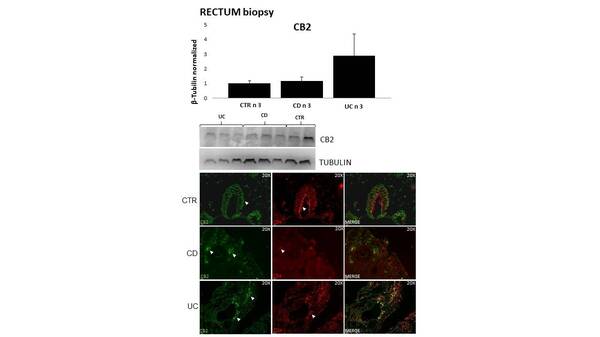P076 The endocannabinoid system in the intestinal biopsies of children with Inflammatory Bowel Disease
Creoli, M.(1);Strisciuglio, C.(2); Vitale, A.(2); Oglio, F.(3);Paino, S.(1);Luongo, L.(1);Tortora, C.(2);Argenziano, M.(2); Di Paola, A.(1);Maione, S.(1);Rossi, F.(2);
(1)Università degli Studi della Campania 'L.Vanvitelli', Department of Experimental Medicine, Naples, Italy;(2)Università degli Studi della Campania 'L.Vanvitelli', Department of Woman- Child and General and Specialized Surgery, Naples, Italy;(3)Università degli Studi di Napoli 'Federico II, Department of Translational Medical Science, Naples, Italy
Background
The endocannabinoid ( EC) system has been recently indicated as a possible therapeutic target in inflammatory bowel disease patients (IBD). G-protein-coupled cannabinoid receptors type 1 and 2 (CB1 and CB2) are the two most important components of the EC system. In our previous study, we demonstrated that a specific CB2 variant contributes to the risk for pediatric IBD, especially UC, and that this variant is associated with a more severe phenotype in both UC and CD. The aim of this study was to directly evaluate on intestinal biopsies of pediatric IBD patients the expression of EC system receptors and of several molecules associated with inflammatory pathway in IBD.
Methods
In this preliminary study, we analyzed the CB1 and CB2 expression in the intestinal mucosa of paediatric patients affected by Crohn's disease (CD) or ulcerative colitis (UC), recruited at diagnosis, and of non-IBD healthy controls (HC). Three patients were enrolled for each group. In particular, we analyzed biopsies taken from the ileum and rectum, which are the tract often more inflamed in CD and UC respectively. Moreover, we evaluated Toll-like receptor 4 (TLR 4), interleukin- 6 (IL6), interleukin-1 β (IL1-β), prokineticin receptor 2 (PKR2) expression, which are known as pro-inflammatory elements. The expression of these receptors and pro- inflammatory cytokines was analyzed by western blot and immunofluorescence.
Results
We found an increased expression of CB2 and TLR4 in UC rectum biopsies compared to CD and HC children. Accordingly, there was also a significant increase of IL-6 expression in UC rectum biopsies compared to CD and HC children (p≤0.05 UC vs HC), as well as, we identified a high expression of IL-6 in CD ileum compared to UC and HC patients. Moreover, in CD ileum, we found an increase in TLR4 compared to UC and HC ileum. We did not find statistical difference for the low number of analyzed samples, but to be a preliminary work we are confident to reach statistical significance increasing the samples enrolled.
Conclusion
In according with our previous data, our results confirm that the EC system and in particular the receptor CB2 is more expressed in the intestine of IBD patients, especially in the rectum of UC patients, which is the tract with greater inflammatory involvement. We can speculate that CB2 receptor is involved in the pathogenesis of paediatric IBD, but additional functional studies are required to understand how the EC system contributes to disease development in pediatric IBD, and if these cannabinoid receptors might represent a new disease marker and could be used as a potential therapeutic target.
Expression of CB2 receptor in rectum biopsies


